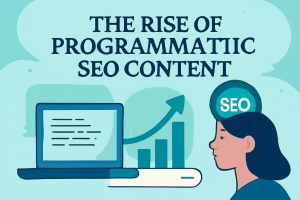Programmatic SEO Content: A Scalable Strategy for Dominating Search Rankings
In the advanced marketing scene, creating Content that ranks on Search Engines is a pivotal objective for businesses, bloggers, and media brands alike. However, conventional SEO Content strategies—relying on manual keyword research, content generation, and optimization—are time-consuming and resource-intensive. That’s where Programmatic SEO Content comes in.
Programmatic SEO Content is revolutionizing how marketers and businesses approach Search Engine Optimization. By leveraging automation and structured data, this strategy allows for the creation of thousands (or even millions) of SEO-optimized landing pages at scale. It’s especially effective for businesses operating in niche markets or those aiming to capture long-tail keyword traffic.
This comprehensive guide will break down what Programmatic SEO Content is, how it works, its benefits and drawbacks, real-world examples, and how you can implement it successfully for your website.
What Is Programmatic SEO Content?
Programmatic SEO Content is a strategy of creating large volumes of search-optimized content through automation, templates, and structured data. Instead of manually creating each blog post or landing page, you design content templates that dynamically generate pages from a dataset.
Key Components:
| Component | Description |
|---|---|
| Templates | Pre-designed HTML/CMS formats used for content formatting. |
| Data | An organized dataset (e.g., a CSV file or a database) that feeds the content. |
| Automation | Scripts or platforms that automatically generate pages based on the template and dataset. |
This strategy is perfect for websites that require creating thousands of variations of similar content based on location, product type, services, or comparisons.

The Rise of Programmatic SEO Content
With advancements in AI, content automation tools, and structured data platforms, Programmatic SEO Content has evolved from a niche strategy to a mainstream tactic. Brands like Cry, TripAdvisor, Glassdoor, and Zapier have successfully utilized it to scale their SEO efforts.
Why It’s Growing:
- Google’s algorithm increasingly favors comprehensive and specific answers.
- Long-tail keywords account for over 70% of search traffic.
- Manual content creation is slow and expensive.
- Competition for top-ranking keywords is fiercer than ever.
Benefits of Programmatic SEO Content
There are numerous advantages to using Programmatic SEO Content, especially for scaling up your content marketing without inflating your budget.
- Enormous Scalability: The most obvious benefit is the ability to create thousands of pages without manually writing each one. You can dominate long-tail keyword clusters in weeks instead of years.
- Consistent Optimization: Templates ensure each page is correctly optimized with title tags, headers, internal links, and schema markup, improving your chances of ranking.
- Data-Driven Accuracy: Since content is based on structured datasets, there’s less chance of real errors, and it’s easier to update content at scale.
- Higher ROI: After initial setup, ongoing costs are low compared to manual content creation. This makes Programmatic SEO a cost-effective long-term investment.
- Speed to Market: Need to roll out content across 10,000 cities? With Programmatic SEO, you can do that in days, not months.
When to Utilize Programmatic SEO Content
Programmatic SEO Content works best in certain situations. Here are a few ideal use cases:
- Local SEO Pages: If your business operates in multiple locations, you can create localized pages for each city or neighborhood, using the same content structure but different local data.
- Product or Service Comparisons: Tech review sites can generate pages like “Best Tablets Under $1000 in California” or “Top Noise-Canceling Headphones for Travelers.”
- Real Estate Listings: Create pages based on city, neighborhood, and property type, using data feeds from your real estate database.
- Job Boards: Generate listings by job type, location, and company using Programmatic methods.
- Directory or Aggregator Sites: If you manage a directory of businesses, courses, recipes, or other listings, you can create content-rich landing pages for each entry.
How to Build a Programmatic SEO Content Strategy
Here’s a step-by-step guide to building an effective Programmatic SEO Content strategy.
Step 1: Research at Scale
Use SEO tools like Ahrefs, SEMrush, or Google Keyword Planner to identify:
- Long-tail keywords
- Keyword patterns (e.g., “Best [item] in [location]”)
- High-volume, low-competition terms
Export and organize your keywords into categories to fit your dataset.
Step 2: Collect and Structure Your Data
Gather relevant data that can be used to populate your pages. This can include:
- City names and demographics
- Product specifications
- Service features
- Reviews or ratings
- Prices and availability
Use tools like Airtable, Google Sheets, or SQL databases for data storage.
Step 3: Create a Content Template
Design layouts that can accommodate variations in:
- Headings (H1, H2, H3)
- Meta descriptions
- Body content
- Tables, lists, or bullet points
- CTAs and internal links
Step 4: Automate Content Generation
You can use tools like:
- Webflow CMS + Airtable + Zapier
- WordPress with custom PHP scripts or plugins
- Custom-built platforms in Python, Node.js, or Ruby
Step 5: Quality Assurance and Review
While automation is efficient, manual quality checks are critical:
- Check for grammar and tone consistency.
- Remove duplicate content.
- Optimize page load speed and mobile compatibility.
- Use AI writing assistants (like ChatGPT) to improve uniqueness and tone.
Common Mistakes in Programmatic SEO Content
While this strategy can be highly effective, it comes with risks. Avoid these common mistakes:
- Lean Content: Google penalizes sites with low-value, repetitive pages. Ensure each page provides unique value.
- Duplicate Content: Ensure similar pages are sufficiently differentiated through variations in data and content structure.
- Poor Format Design: If your format is not engaging or SEO-optimized, even thousands of pages won’t help.
- Ignoring Internal Linking: Include links to related pages to boost crawlability and improve UX.
- Low-Quality Data: If your source data is outdated or incorrect, the generated content will reflect that.
Examples of Effective Programmatic SEO Content
- Zapier: Zapier creates thousands of pages focusing on integrations between devices like “Connect Gmail with Google Sheets.” These pages follow the same format and are dynamically generated based on structured data.
- Yelp: Yelp uses Programmatic SEO to create location-based listings like “Top Mexican Restaurants in Los Angeles.” Each page uses the same format, populated with local business data.
- Airbnb: Airbnb uses dynamic pages for “Vacation Rentals in [City],” where data comes from listings and reviews. SEO optimization is built into the structure.
Tools and Platforms for Programmatic SEO Content
To implement an effective strategy, consider using these tools:
CMS Platforms:
- Webflow CMS: Excellent for visual builders and designers.
- WordPress: Scalable with plugins like WP All Import.
- Contentful or Strapi: Headless CMS options.
Automation Tools:
- Zapier: Connects data sources to CMS.
- Integromat (Make.com): Advanced data workflows.
- Python or Node.js: Custom automation scripting.
Data Management:
- Airtable: User-friendly database with rich fields.
- Google Sheets: Simple but effective for small-scale operations.
- SQL Database: For enterprise-level data management.
SEO Optimization:
- Surfer SEO: Optimize templates for keyword density.
- Clearscope: Enhances content relevance.
- Screaming Frog: For site audits and QA.
Future of Programmatic SEO Content
The future of Programmatic SEO Content is bright, thanks to advancements in AI and natural language processing. Anticipated trends include:
- AI-Powered Customization: Tools like GPT-4 and Gemini can add unique intros, outlines, and perspectives to each page, improving content depth and avoiding penalties for lean content.
- Voice and Visual Search Integration: Pages optimized for voice queries (e.g., “best sushi places near me”) will become more prominent. Images, maps, and video content will be automatically included in templates.
- Personalization: Combining Programmatic SEO with user behavior data will allow pages to adapt dynamically, offering personalized experiences.
- Enhanced Crawl Optimization: Google is favoring high-performing, fast-loading pages. Expect tighter integration with Core Web Vitals in future templates.
Final Thoughts
Programmatic SEO Content is a game-changer for digital marketers looking to scale their content strategy quickly and efficiently. While it’s not a silver bullet, when implemented correctly, with attention to quality, user experience, and SEO best practices, it can drive exponential growth in search traffic and conversions.
Whether you’re managing a travel aggregator, an e-commerce marketplace, or a niche directory site, investing in Programmatic SEO Content is a smart step toward long-term search visibility and competitive advantage.
